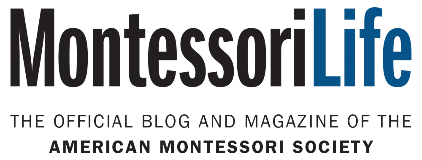The Montessori Method completely revolutionizes the traditional approach to education, introducing a holistic model that focuses on meeting each child where they are and providing adaptive approaches to meet their individual needs. The multi-age composition of classrooms, the hands-on approach to learning, the freedom within limits, and the individual pacing of instruction that is provided in a Montessori classroom encourage and promote success for students, including those with learning differences.
Researchers and practitioners have noticed a rise in the number of students with neurodiversity over the last several years. Additionally, the number of students presenting or diagnosed with attentional issues, Autism Spectrum Disorders, and sensory integration difficulties continues to increase. These rising numbers present a challenge to educators to adequately and compassionately meet these childrens’ needs, but Montessorians may have an advantage given the nature of the Method and their practical expertise. After all, even though the Montessori Method is used with children with a range of learning abilities today, the foundation for Dr. Maria Montessori’s educational approach developed from her initial work with neurodivergent children.
How Does the Montessori Pedagogy Support Children with Learning Differences?
During her time in the classroom, Dr. Montessori developed an educational pedagogy that includes an “emphasis on hands-on, differentiated, self-paced learning guided by intensive and ongoing child study [that] provides a template for best practice in both general and exceptional classrooms.” The degree of personal involvement and independence that is promoted in a Montessori classroom setting is precisely the outcome that many individualized education programs (IEPs) are developed to achieve. Pillars of Montessori pedagogy including choice, freedom of movement, and extended periods of deep concentration also happen to be recommended strategies for students with learning differences. Additionally, the elements recommended for monitoring in order to identify children with learning differences include coordination, language, attention, and perception—all areas which can clearly be observed in the Montessori setting. Particularly, the Sensorial curriculum allows Montessori guides to observe a child’s perceptual development which is often diagnostic of uneven development (Pickering 2017, 49-53).
What Does the Process for Identification Look Like in a Montessori Setting and What Support Systems May be Provided?
The process for identifying a student with a learning difference bears much resemblance to the naturalistic observational practices of Montessorians; a Montessori guide carefully and subjectively observes their students on a regular basis. Over the course of their observations, the guide might begin to notice some concerns regarding a child’s development. With documentation to substantiate their concern, the guide may then bring their concerns to an administrator who would initiate a child study team meeting. This team often involves the child’s teacher, their parents/caregivers, an administrator, and any other support services personnel that may be beneficial in discussing the challenges the child is facing. It is important to note that this process does not occur in all Montessori schools, but can be used as a model to guide the process.
The child study team meets to determine individualized goals for the child and develop a plan to help them successfully meet their goals in the classroom. The supports utilized to assist a child in meeting their goals might include a visual schedule, prompts for upcoming transitions, or cool-down techniques to manage heightened emotions. Traditional strategies naturally occurring in a Montessori classroom might include preferential seating and extended time. There are some accommodations Montessori guides can make to assist students with neurodivergence including reducing the difficulty level, limiting stimuli, and providing repetition. There are specific adaptations that can be made to some traditional Montessori lessons and activities for children ages 3 – 6 with learning differences. At a second, more intensive tier of support, a student would continue receiving accommodations in the classroom and may also receive individualized instruction from an outside therapist such as a Speech Pathologist or Vision Therapist to provide more targeted remediation. It is important to note that depending upon the resources available at the school, this may be a service that parents need to arrange outside of the school setting and may need to fund independently.
Throughout the entire process of providing interventions and support, members of the child study team would continue to carefully observe the child, monitoring their progress and meeting regularly to discuss the implementation of the plan and any changes that might need to be made along the way. Goals may also be updated or replaced as the child continues making progress. In the event that the child does not make adequate progress once these supports have been put into place and accommodations have been made, the child study team may recommend that the parent seek further testing for their child to identify any specific learning disabilities that might exist. Although a diagnosis would not change the individualized approach to education provided in a Montessori classroom, a licensed practitioner may be able to provide recommendations for targeted supports that would allow the child to experience a heightened level of success in the classroom.
The systematic observations, detailed record keeping, and individualized support offered in a Montessori classroom are key components of the child study process as they allow for the identification and support of neurodivergent children. The hands-on approach to learning the Montessori pedagogy presents and the freedom of choice and movement that exists naturally in a Montessori setting allow Montessorians to provide a foundation that can help promote success for many students, including those with learning differences. It is important to mention, however, that there are circumstances when guides may need additional support or guidance from specialists to best meet a neurodivergent student’s needs such as when the Montessori environment and its materials are overstimulating.
Perhaps most importantly, the Montessori approach to education (and to life) promotes love, acceptance, equity, and justice. Individuals from all racial, cultural, and ethnic backgrounds are valued and appreciated in Montessori classrooms around the world. Similarly, students are recognized and accepted for their unique talents and differences and are celebrated for their individual potential and growth. As Jacqueline Cossentino reminds us, “Montessorians are trained to perceive every child as exceptional and, in response, to hold flexible individualized instruction in the highest regard.” The genuine care and devotion students receive within Montessori settings provides a level of support that is unparalleled and promotes learning, growth, success, peacefulness, and joyfulness for all within equitable learning environments.
Reference List
Pickering, Joyce. Montessori for Children with Learning Differences. Montessori Life. Spring 2017. 49-53.
The opinions expressed in Montessori Life are those of the authors and do not necessarily represent the position of AMS.


